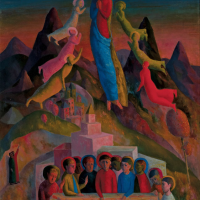69. JUSTIN O'BRIEN

The religious experience should not be confused with the spiritual experience 1
This beautifully compact composition of one of Justin OBriens favourite biblical themes, gives pause to reflect on the long morphing evolution of the Blake Prize for Religious Art since its establishment in Sydney in 1949. Its very first award in 1951 was given to OBrien for one of his biggest paintings before or since, an ambitious triptych titled The Virgin Enthroned.
This Prize was conceived to address a need for the salvation of religious art during the modern era, in the hope that outstanding exponents would encourage a time-honoured tradition of decorating churches. However, it proved to be, as Natalie Wilson wrote, predominantly another opportunity for local artists, scrambling for copies of the King James Bible, to simply expose their work to the public.2
After two years in Europe from 1948, OBrien returned to Sydney confirmed by the potency of religious imagery of old masters he had experienced in museums and churches as well all aspects of his Catholic faith. After winning the first Blake Prize of 1951, he submitted The Assumption of the Virgin to the second Prize in 1952.
He did not win this time, but the aesthetic shift between these two masterpieces is fascinating. In the former, within its strict predella format, all figures are anchored to the realm of earth, hemmed in, and assured by bare mountains against the upper edge of the composition. In The Assumption of the Virgin however, there is a sense of ecstatic release through the levitation of the Virgin and angels above, and beyond the dark mountains and tomb below, to an exquisite strip of deep blue heaven and a beckoning nightfall.
Those dark mountains presaged a bleak year to follow. In 1953 OBriens Irish mother became ill and died. He was devastated, feeling his religious faith had failed him and, after a few months travelling again in Europe and Ireland, returned to Sydney and entirely rejected the church and its precepts. He continued to depict religious themes, but secular subjects like flower pieces, still-lifes, portraits and interiors began to proliferate amongst the saints, angels, and Madonnas.
What does The Assumption of the Virgin tell us about OBriens quintessential motivation as a painter? Is it principally related to a declaration of faith? This would be a natural conclusion given the common assumption that Byzantine art, via an obsession with Duccios Maesta altarpiece in Siena, must have been integral to his artistic genesis. However, this has been largely disputed by Sasha Grishin:
At no stage did OBrien work in a Byzantine style, in fact he was somewhat disparaging about Byzantine art and its dry mannered forms. Even in his earliest work stylistic morphology points clearly to the early Italian Renaissance. OBrien balances the extreme emotionalism of the subject matter with the utmost restraint and depersonalised treatment to create a profound sense of pathos.3
In fact, The Assumption of the Virgin yields itself to our gaze today more effectively through submission to a language of modernism; especially if we recall that, as a prisoner-of-war, the artist discovered paintings through books provided by the Red Cross, not of the Byzantines, nor the Renaissance, but Modigliani, Derain, Matisse, van Gogh and Gauguin. Those moderns suited his way forward and a desire to be recognized as a contemporary painter.
Then, following the war, as the Blake Prize became something of a bulwark against the rising tide of abstraction, the bold juxtapositions of pink, blue and green of this painting chimed with a mystical subjectivity closer to the French Symbolists, and the words of a critic who wrote:
The canvas is saturated with colour, yet never spills over into chaos, for the control is assured and complete. OBrien uses colour as a composer uses sound.4
Finally, The Assumption of the Virgin reminds us of one other important recurring trope: absolute symmetry with either Christ or the Madonna at the vertical centre of the picture plane, flanked by angels or donors to form a classic triangular stability. Jeffrey Smart (1921-2013), fellow expatriate of OBrien who had settled permanently in Rome since 1972 and who once intended to write a book about his friend, was asked about this trope.
He said that it must be borne in mind Justin placed particular significance on the aura of stillness in a composition, to capture a brief moment before it disappeared, and always most perfectly achieved through symmetry. For this he referred to two great works by Piero della Francesca: The Resurrection in Borgo Sansepolcro, and the Madonna del Parto in Monterchi; two murals Smart and OBrien both profoundly admired.5
OBrien may have abandoned his faith shortly after painting The Assumption of the Virgin for the Blake Prize. But his abandoned faith continued to provide scaffolding for his most deeply resonant masterpieces, such as this. Faith, from the very beginning, was destined to be allied, and answerable, to an aesthetic.
Footnotes:
1. Justin OBrien, quoted in Grishin, S., Justin OBrien: A Survey Exhibition 1938-1999, Philip Bacon Galleries, Brisbane, 2006, p.15
2. Pearce, B. & Wilson, N., Justin OBrien: The Sacred Music of Colour, Art Gallery of New South Wales, Sydney, 2010, p.61
3. Grishin, op. cit., p.9
4. James Gleeson, quoted in Pearce & Wilson, op. cit., p.86
5. Based on conversations with the author.
Barry Pearce
Barry Pearce is Emeritus Curator of Australian Art at the Art Gallery of New South Wales. He is responsible for many exhibitions and publications and is the author of Brett Whiteley: Art & Life (1995) and Sidney Nolan: Retrospective (2007).